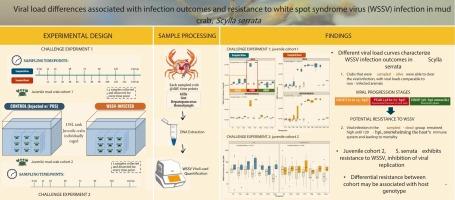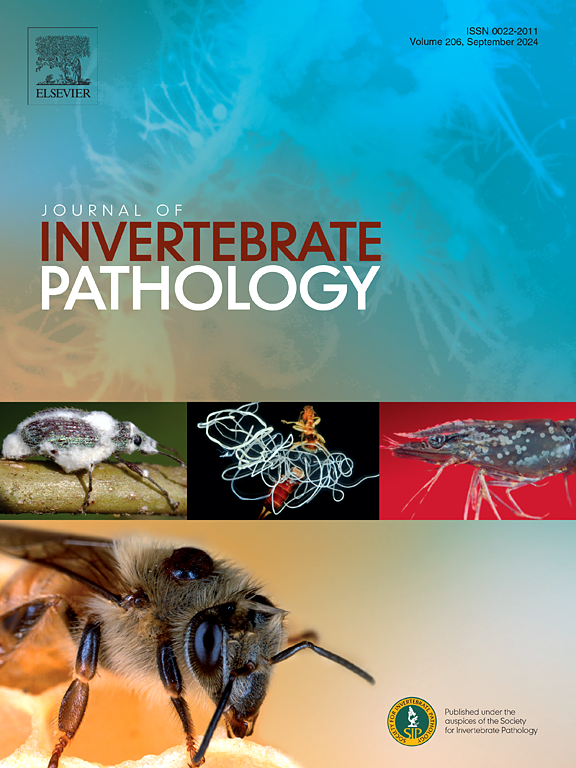Scylla serrata泥蟹感染结果和对白斑综合征病毒(WSSV)感染抗性相关的病毒载量差异
IF 2.4
3区 生物学
Q1 ZOOLOGY
引用次数: 0
摘要
白斑综合征病毒(White spot syndrome virus, WSSV)是白斑病的病原,对甲壳类水产养殖造成严重威胁。感染广泛的甲壳类动物,宿主物种表现出不同的易感性和死亡率。泥蟹(Scylla serrata)是印度-太平洋地区的一种高价值水产养殖商品,已知对WSSV具有相对抗性。然而,关于该物种中WSSV感染进展的信息有限,这可以为抗性机制提供深入了解。本研究采用WSSV对serrata s.s serrata进行时间过程实验,表征了感染后144 h (hpi)期间青少年病毒载量动态与(1)疾病结局(生存或死亡率)的关系;(2)组织类型(鳃、肠、肝胰腺、血淋巴)的分布;(3)两个不同青少年群体之间的差异性。病毒载量的进展表明,泥蟹对WSSV的抗性可能是由于两种不同的机制。一种机制涉及到s.s serrata在活跃的病毒复制后清除病毒的能力。serrata的病毒生长表现为三个阶段:早期或以病毒载量变化最小为特征(0至24 hpi),活跃复制的对数阶段,病毒拷贝数迅速增加(24至72 hpi),第三阶段(96-144 hpi),表现出与感染结果不同的模式。死蟹表现出平台期,病毒载量保持与峰值水平相似,而存活超过96 hpi的螃蟹表现出分解期,其特征是病毒载量减少,恢复到未感染水平。WSSV抗性的另一个明显机制涉及复制的全面抑制,在预期的对数感染期时间点(48-72 hpi),抗性个体表现出明显的低病毒载量。本研究还揭示了WSSV在锯齿蛇中的组织趋向性。鳃似乎是WSSV复制的主要部位,与其他组织类型(如肠道、肝胰腺和血淋巴)相比,从感染的早期到高峰阶段,鳃表现出最高的病毒载量。通过建立病毒载量曲线来跟踪WSSV感染的进展,以及在感染过程中不同组织中病毒丰度的表征,代表了对serrata作为WSSV携带者/载体的作用具有关键意义的新信息。这可能对水产养殖设施的疾病缓解措施以及制定预防和减少泥蟹病原体感染的新战略具有实际意义,以支持可持续水产养殖生产。本文章由计算机程序翻译,如有差异,请以英文原文为准。

Viral load differences associated with infection outcomes and resistance to white spot syndrome virus (WSSV) infection in mud crab, Scylla serrata
White spot syndrome virus (WSSV), the causative agent of white spot disease, remains a serious threat to crustacean aquaculture. Infecting a wide range of crustaceans, host species exhibit varying susceptibility and mortality rates. Mud crabs, Scylla serrata, a high-value aquaculture commodity across the Indo-Pacific region, are known to be relatively resistant to WSSV. However, there is limited information on the progression of WSSV infection in the species which can provide insight into mechanisms of resistance. Employing a time course experimental challenge of S. serrata with WSSV, this study characterized viral load dynamics in juveniles over a period of 144 h post infection (hpi) in relation to (1) disease outcomes (survival or mortality); (2) distribution among tissue types (gills, gut, hepatopancreas, and hemolymph); and (3) variability between two different juvenile cohorts. Viral load progression suggests that WSSV resistance in mud crabs may be due to two distinct mechanisms. One mechanism involves the capability of S. serrata for viral clearance following active viral replication. Viral growth in S. serrata demonstrates three phases: early stage or onset characterized by minimal change in viral load (0 to 24-hpi), logarithmic stage of active replication with rapid increase in viral copy number (24 to 72-hpi), with the third phase (96–144 hpi), exhibiting differential patterns with infection outcome. Dead crabs exhibited a plateau phase where viral loads remained similar to peak levels, while crabs that were still alive beyond 96 hpi exhibited a resolution phase, characterized by reduction in viral load, returning to non-infected levels. Another apparent mechanism for WSSV resistance involved overall inhibition of replication, with recalcitrant individuals exhibiting markedly low viral loads at expected logarithmic infection phase timepoints (48–72 hpi). This study also revealed tissue tropism of WSSV in S. serrata. Gills appear to be the primary site of WSSV replication, exhibiting the highest viral load from the early to peak stages of infection compared to other tissue types such as the gut, hepatopancreas, and hemolymph. The establishment of viral load curves to track the progression of WSSV infection, and characterization of viral abundance across different tissues through the course of infection, represents novel information that has key implications on the role of S. serrata as carriers/vectors of WSSV. This may have practical implications for disease mitigation measures for aquaculture facilities, and development of new strategies to prevent and reduce pathogen infection in mud crab to support sustainable aquaculture production.
求助全文
通过发布文献求助,成功后即可免费获取论文全文。
去求助
来源期刊
CiteScore
6.10
自引率
5.90%
发文量
94
审稿时长
1 months
期刊介绍:
The Journal of Invertebrate Pathology presents original research articles and notes on the induction and pathogenesis of diseases of invertebrates, including the suppression of diseases in beneficial species, and the use of diseases in controlling undesirable species. In addition, the journal publishes the results of physiological, morphological, genetic, immunological and ecological studies as related to the etiologic agents of diseases of invertebrates.
The Journal of Invertebrate Pathology is the adopted journal of the Society for Invertebrate Pathology, and is available to SIP members at a special reduced price.

 求助内容:
求助内容: 应助结果提醒方式:
应助结果提醒方式:


